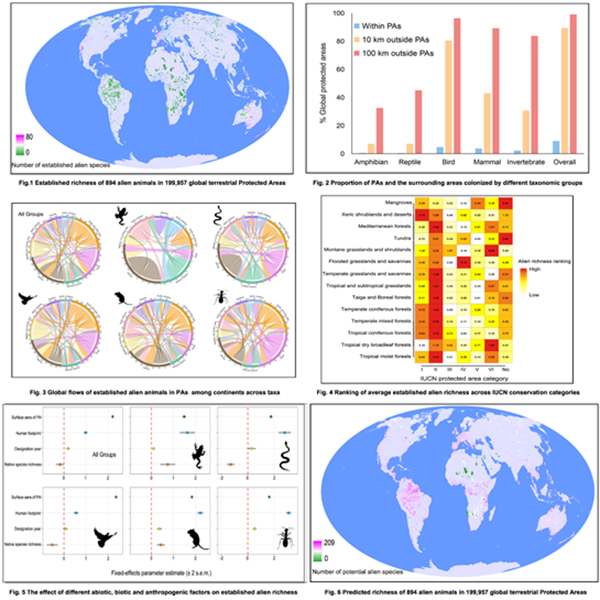Protected areas (PAs) are regarded as the cornerstone of native biodiversity. However, their unique role in protecting native biodiversity is likely to be affected by increasing invasive alien species in the era of globalization. Unfortunately, the extent to which protected areas worldwide are resistant to incursions of alien species remains unknown. Identifying those PAs harboring a high richness of alien species, their potential drivers and future invasion risks will shed important light on these incursions, and provide important information to develop efficient prevention, detection, and rapid response strategies against new invasions in PAs. Prof. Yiming Li’s team from the Institute of Zoology, Chinese Academy of Sciences has worked with Prof. Tim Blackburn from University College London, and published a study entitled “Animal invaders threaten protected areas worldwide” in the journal Nature Communications on June 8th, 2020. This study for the first time assessed the establishment and potential drivers of 894 terrestrial alien animal species across broad taxonomic groups (77 invertebrates, 98 amphibians, 178 reptiles, 391 birds and 150 mammals) in 199,957 global terrestrial PAs. The authors found that PAs have to date generally been effective in resisting alien animal incursions as only 9.1% of PAs are home to any of the alien animals (Figs. 1-2). However, 89.4% of PAs had at least one established population of an alien animal within 10 km of their boundaries (Fig. 2). The geographic flows of alien animal species established in PAs were dominated by exchanges between areas within continents (Fig. 3). The largest proportion of invaded PAs was colonized by alien birds, followed by mammals, invertebrates, amphibians, and reptiles. The (sub)tropical Pacific and Caribbean Islands and New Zealand, flooded grasslands and savannas in Florida, and temperate mixed forests, grasslands and savannas in western Europe, Australasia and US western states, represented higher-richness regions (Fig. 1). The highest level of incursion was observed in supposedly relatively well protected IUCN level-II parks for most ecoregions across taxa (Fig. 4). There were more alien species incursions into PAs with less native species, more recent designation and higher human footprint, although their relative importance varied across taxa (Fig. 5). Ecological niche modeling analyses showed that more than 95% of PAs were predicted to be environmentally suitable for establishment by the species in our database, suggesting that PAs face high invasion risks from alien animal invaders due to higher environmental suitability under accelerating anthropogenic pressures (Fig. 6). We thus call for immediate international efforts from scientific communities, governments, non-government organizations, landowners and residents to monitor alien species introductions, improve relevant legislation policies and increase public awareness to reduce the extent and magnitude of potential invasions in PAs and their neighbor areas. Xuan Liu*, Tim M. Blackburn, Tianjian Song, Xuyu Wang, Cong Huang, Yiming Li*. Animal invaders threaten protected areas worldwide. Nature Communications. 11, 2892 (2020). https://doi.org/10.1038/s41467-020-16719-2
|

